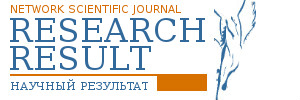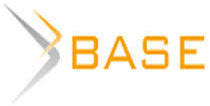METHODS OF SOCIAL AND ENVIRONMENTAL EDUCATION OF STUDENTS
Abstract
In the article the relevance of the research topic is the need to develop methods for the problems of social and environmental education of students. Reveals the etymology of the concept of "method" is considered its essence in the works of various scientists: teachers, psychologists, ecologists, and, on the steps not only common, but also of higher education. The results of the analysis of the achievements of research allowed to define the essence of one of the main components of the social and environmental education of students - the methods of interaction of the teacher and students.
Keywords: method, teaching methods of training and education in higher education, the methods of the social and environmental education of schoolchildren, the methods of social and environmental education of students, the classification methods
The recent period of social development features aggravation of social and ecological conflicts and this is one of its most important characteristics. These conflicts are necessary to be resolved for the further stable social development requires maintenance of favorable environmental conditions as well as of human health, health of every individual and of nature potential for human living.
Students are destined to play an important role in overcoming the mentioned conflicts. Nevertheless the efficiency of solving of the occurring social and environmental problems largely depends on the level of training of youth, best practices of interaction with natural environment assimilated by them, ability to study, protect, recover and renew natural conditions and resources. Expansion and enrichment of such experience, further development of the ability to optimize social and environmental relationships are to a large extent connected with ecologization of the purposes and contents of education, in particular higher education, with the necessity to form in future specialists both long-lasting social and environmental knowledge and skills of rational nature management, harmonic interaction with the environment, preservation of its potential for the future generations. Therefore there is a need of special social and environmental education of students which would be closely related to their professional training since each profession is someway or other connected with natural environment, uses its potential and at the same time offers definite opportunities for its preservation and recovery.
On the other hand provision of definite level of social and environmental education of students requires development of special diagnostics, finding out certain methods of implementation and depending on the results introduction of necessary changes into an educational process.
Besides study of the problem of social and environmental education of students requires determination of methods of interaction between a teacher and students which is one of the most important elements in an educational process. It is known that a method (methodos from Greek stands for a way, an exploration, an investigation) first of all means a way of cognition, investigation of phenomena of natural and social life; secondly its means a mode/way of operation. It is a means of pursuing a certain objective, a complex of techniques or operations aimed at practical or theoretical assimilation of reality [4].
In pedagogy the researchers understand a teaching method as a way of interaction of a teacher and pupils, of arrangement of cognitive activity of the latter which is oriented at solution of education tasks. At that a method structure is determined through interrelation of techniques or operations, sequential operations of an individual leading to achievement of a result which complies with the stated objective. As Lerner I.Ya. reasonably noted a method in use presupposes a stated objective, an activity complying with the purpose (a system of actions), the necessary means, a process of an object change and a result (an achieved purpose). At that special attention is paid to the presence of the method peculiarities which are conditioned by an object-subject status of students whose activity as well as the corresponding activity of a teacher depends on their interests and will. With mismatching objectives the educative process can hardly demonstrate any progress. In order to achieve progress in movement towards educational goals the students’ and the teacher’s objectives should adequately fit each other. Various classifications of methods representing any of the features or aspects of interaction between a teacher and students and being elaborated in theory favor education goals achievement [3; 5; 6].
After consideration of the methods of education used in the higher school it is worth noting that their essence remains unchanged, traditional variants of classification are still of importance. Smirnov S.D. draws attention to this fact and makes distinction between teaching methods (lecture, narrative, presentation-demonstration, explanation, conversation etc.); education methods (listening, understanding, exercises, work with a textbook, historical and pedagogical modeling, practical work etc); methods of testing (interrogation, test works, colloquium, test, exam, defense of theses etc.). The author mentions other groups of methods quite common for pedagogical science. These include verbal, graphical, practical, diversified by a knowledge source, methods of acquisition of knowledge and formation of skills (depending on the nature of a didactic task); methods of creative activity formation, testing methods; gaming methods; methods of intensive learning of foreign languages; methods of programmed education; methods of computer-aided education etc [11].
As far as the methods of students upbringing are concerned Smirnov S.D. makes quite reasonable remarks as to existence of definite difficulties connected with their differentiation (in a narrow sense) in the higher school and classification since upbringing is directly incorporated into the process of education and has immediate relation to the same (Smirnov S.D., Kharlamov I.F., Pidkasistyi P.I. et al) [8; 9; 11]. In the meantime higher educational institutions quite successfully use a classification of the methods of upbringing developed by Babanskiy Yu.K. and Slastenin V.A. who marked out the following groups of methods: methods of impacting conscious of an individual, methods of organization of activity and behavior of pupils, methods of stimulation and methods of control [2; 8; 12]. By covering the basic components of structure of personality these methods promote implementation of a learner-centered approach in education, have positive impact on the results of education and upbringing.
All of the above constituted a ground for development of an essence and classification of methods of social and environmental education of students. It is necessary to mention that we’ve determined the essence of the methods of social and environmental education of pupils in the general education institutions. In simple terms the method of social and environmental education (teaching and upbringing) is understood as a mode of interrelated activity of a teacher and pupils aimed at organization of acquisition of social and environmental knowledge and skills by schoolchildren and use of innovations in concert with the environment; forming of positive emotions connected with natural environment, sense of proportion in the process of natural potential use; at understanding the necessity of its preservation and recovery. In other words it’s a method of subject-subject and subject-object interaction which contributes to assimilation of contents of the social and environmental education school curriculum, formation of readiness to normative nature management in schoolchildren, formation of their social and environmental consciousness [14].
The discovered essence allowed us to determine the essence of the methods of social and environmental education of students as conditioned by specific objectives and contents. Methods in the system of social and environmental education of students are understood as modes of interaction between a teacher and students aimed at:
- acquisition of social and environmental knowledge which penetrates through a professional, personal and psychological-pedagogical content units;
- development of a motivational sphere (demands, incentives, objectives, attitudes, interests) connected with rational nature management (study, use, protection, recovery and renewal of natural environment);
- formation of skills of interaction with natural environment (at the level of exchange processes, nature management and labor activity);
- detection of creative potential oriented at creative activity in natural environment;
- formation of derived emotions connected with satisfaction of social and environmental demands;
- organization of educational activities favoring both acquisition of experience in social and environmental relationships and formation of skills of self-education, creative self-actualization in natural environment; emotional-volitional self-adjustment in the process of interaction with it.
It’s obvious that the methods of social and ecological education of students in regard of content are represented by a complex system of actions, interrelation between techniques and procedures conditioned by the objectives of interaction of objects with environment, its cognition and practical assimilation under the specially created conditions. In the course of the SEES methods identification we were governed by the results of cognition of reality by people, in particular of the sphere of social and environmental relationships: its basic elements (nature-technology-human being-society) and links between them; by the results of studying the regulatory documents in the sphere of geographical and historical education (National standard of higher education, curricula, textbooks etc.); by the results of review of the works of Arkhangelskiy S.I., Yakovets Yu.V., Preobrazhenskiy V.S., Gerasimov I.T. and other authors which allowed to make comparison tables for the methods used in geographical and historical sciences [14].
For example the methods of geographical science include various (field method), cartographic, statistical, aerospace methods, modeling of geosystems, geoecological monitoring; systemic, historical and comparative approaches. Historical science provides for the following investigation methods: historiographic, archeology, source studies, historical statistics and metrology, ethnography, archeography [1; 15; 10].
With respect to the social ecology education methods for the moment they are represented by a definite combination of the methods from various types of education which facilitate deeper knowledge of nature, society and culture, their interrelations, every element of the socioenvironmental system. The links between its elements are studied by means of specific approaches, i.e. systemic, functional, ecological, historical, geographical, comparative as well as by definite methods. In other words the methods of social ecology education have complex nature, appear as complementarity of the methods of education used in various sciences which to a certain extent reflect some or other aspect of socioenvironmental interaction which is being studied during a definite time interval [14].
These methods include natural, sign, mathematical, modeling, simulation, computer methods. The mentioned methods are a part of the sciences under consideration however in order to study the same in the process of education it is necessary to involve special ways of interaction between teachers and students which are formed by means of integration of already existing teaching methods; use of various types of modeling (mathematical, simulation, analogue, orthographic etc.) which at the latest time become more and more popular as the methods of teaching and upbringing and it should be noted that they are used under different conditions.
The analysis of theoretical and practical experience allowed us to elaborate an approximate correlation between the investigation methods used in geographical, historical and socioenvironmental sciences, as well as between the principal elements of structure of a personality (related to cognition, activity and the essence of creativity) and the teaching methods used during the educational process in a higher educational institution.
We’d like to demonstrate a combination of methods for formation of the cognitive component:
- sign (verbal) methods: explanation; conversation; discussion; persuasion; positive instance; use of an artificial, statistical language; use of a language of conventional symbols; suggestive methods; suggestion box;
- natural (graphical) methods: use of natural socioenvironmental objects; demonstration; illustration; use of visual aids; observations; experiments;
- modeling (practical) methods: modeling of socioenvironmental situations: experiments, positive instance; study of documentation.
Approximate correlation between the components of structure of a personality, the methods of socioenvironmental investigations and the methods of education in a higher educational institution within the structure of activity-relatedcomponent is as follows:
- sign (verbal) methods: explanation, clarification, instruction, study of historical and geographical sources, pedagogical request, public opinion, suggestion box;
- natural (graphical) methods: demonstration; illustration, tables, use of visual aids, solution of socioenvironmental tasks, expert estimation, field work, ecological monitoring, inurement;
- modeling (practical) methods: exercises, practical work, laboratory work, work with a computer, work with various information sources.
With regard to the component related to the essence of creativity approximate correlation between the components of structure of a personality, the methods of socioenvironmental investigations and the methods of education in a higher educational institution appear to be as follows:
- sign (verbal) methods): discussion, topical narrative, pedagogical request, rewards, punishment, impression-based;
- natural (graphical) methods: observation, positive instance method, use of visual aids;
- modeling (practical) methods: cognitive, experiments, competition in environmental improvement, creation of a successful situation, expressive (The same source).
The identified groups of methods are interrelated by an objective necessity to cover various aspects of personality of a student in the course of studying an integrated content of socioenvironmental curriculum. At time of selection and use of any of the methods it would be useful to take into consideration the opinion of Lerner I.Ya. stating that a method should necessarily correspond to every component of the content being studied [3; 5; 6].
At the same time the methods of socioenvironmental education of students disclose its integrative function, exactly these methods facilitate achievement of the objectives of education, upbringing and personal enhancement of a student in the course of assimilation of complex socioecological content.

















Reference lists